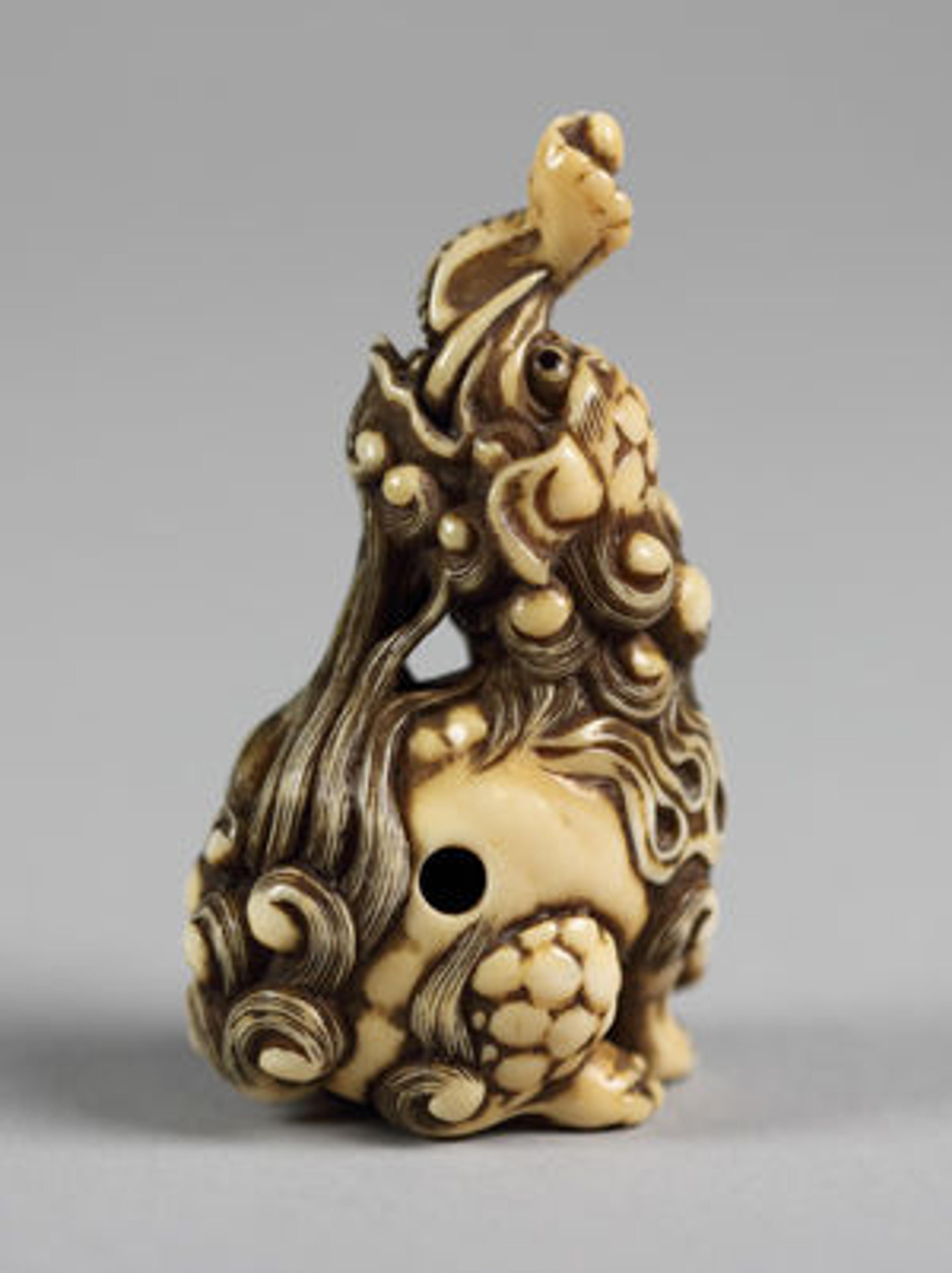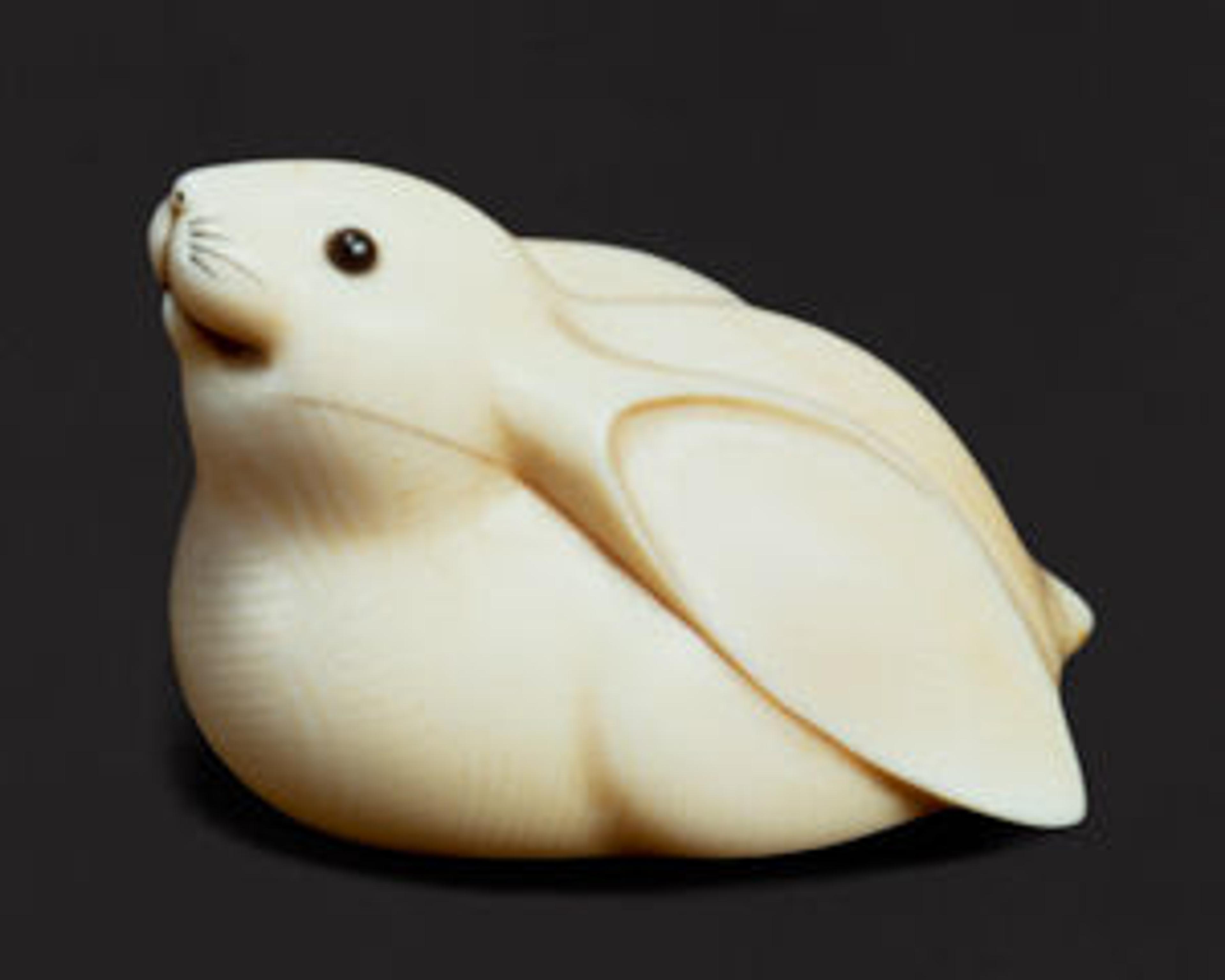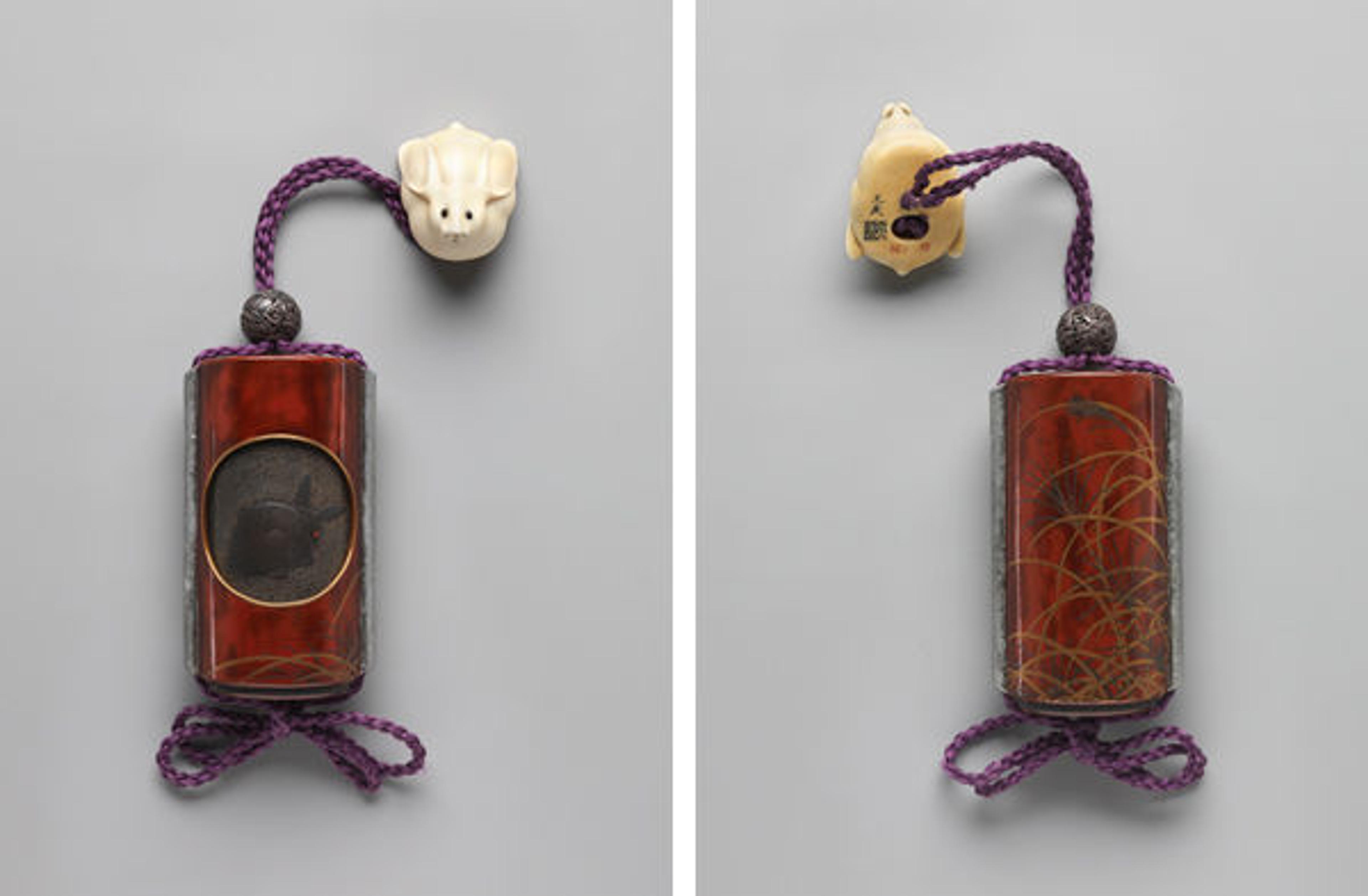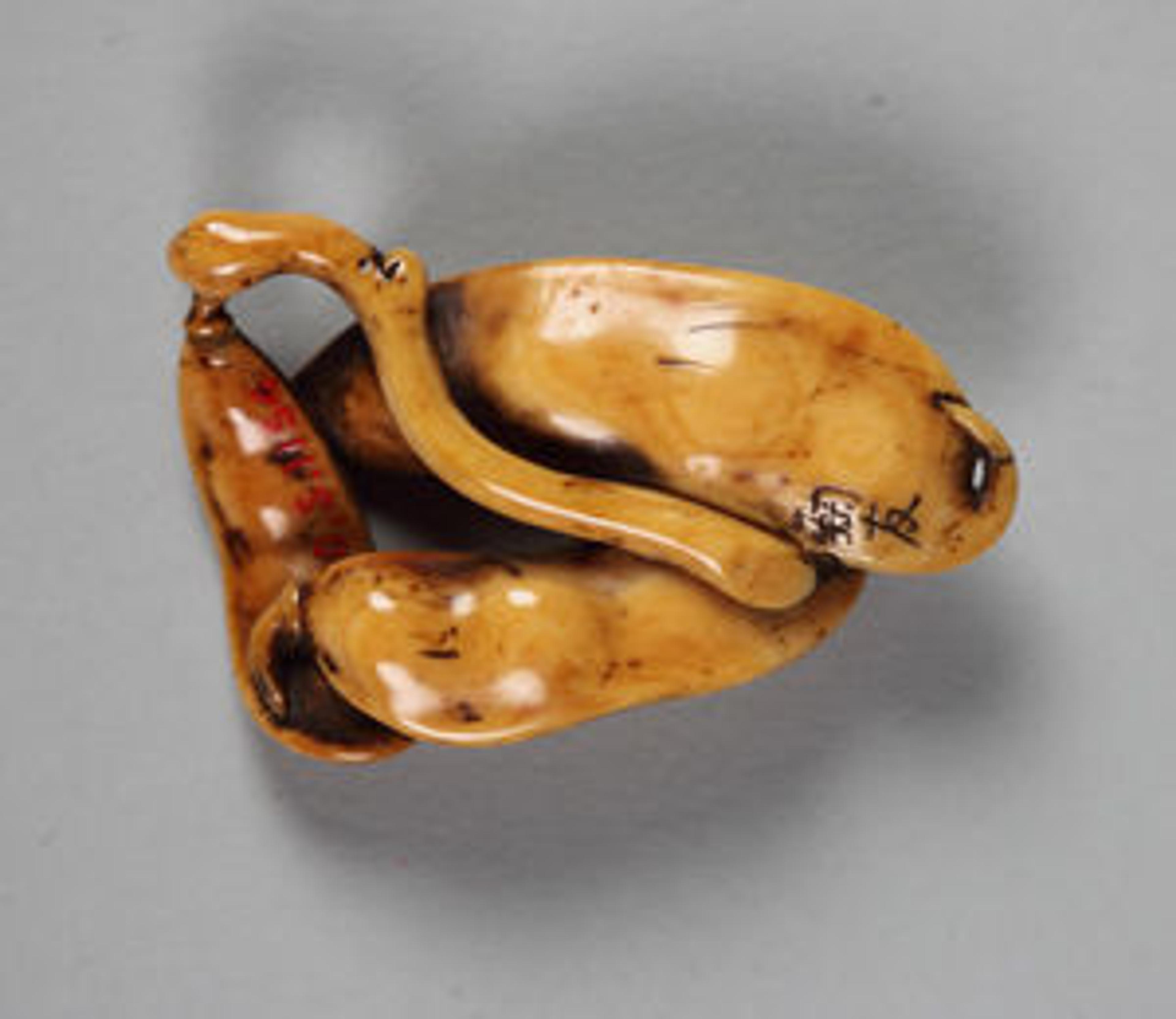Celebrating #NetsukeNovember on Twitter
«The Metropolitan Museum of Art boasts a collection of almost one thousand netsuke, with a particular emphasis on works from the eighteenth and nineteenth centuries. In addition to the selection currently displayed in the exhibition Kimono: A Modern History, on view September 27, 2014–January 19, 2015, daily netsuke posts can also be seen on the Museum's Twitter account throughout the month of November as part of the campaign #NetsukeNovember.»
The Met's netsuke collection reflects American collectors' appreciation and enthusiasm for these small-scale art objects. From the nineteenth century onwards, visitors to Japan from Europe and the United States viewed netsuke as ideal collectibles. These prized souvenirs were seen to encapsulate various aspects of Japanese culture—which ranged from folk tales to Noh theater—in a reduced and eminently portable scale.

Left: Seated Baku, 18th century. Japan, Edo period (1615–1868). Ivory; H. 2 3/4 in. (7 cm); W. 1 in. (2.5 cm); D. 1 1/2 in. (3.8 cm). The Metropolitan Museum of Art, New York, Gift of Mrs. Russell Sage, 1910 (10.211.1105)
While the finest pieces in the collection, such as the netsuke of the mythical nightmare-eating creature baku shown at left, can be appreciated for their aesthetic qualities alone, netsuke were never meant to be simply decorative; rather, their function was primordial, which shaped their stylistic development as much as their sociohistorical context of creation. Visitors to Kimono: A Modern History will know that a sash, or obi, was wrapped around the waist of the wearer to keep the kimono in place. Japanese men carried tobacco, medicines, and seals in a sagemono (a term that designates "hanging things") strung on a cord running under the obi. In both their simplest and more refined forms, netsuke were placed over the upper section of the obi, where they responded to a practical need for a counterweight to prevent sagemono from slipping.
Sagemono took various forms: the attendant dressing the actor Nakamura Rikō I in the woodblock print by Torii Kiyonaga (1752–1815) carries a pouch, while actor Sawamura Sōjūrō III carries a portable medicine case (inrō), discernible beneath his patterned kimono sleeve. These beautifully crafted, stacked lacquer containers were adorned with exquisite designs and complemented by a netsuke, with which the inrō traditionally formed a pair.

Left: Torii Kiyonaga (Japanese, 1752–1815). The Actor Nakamura Rikō I with an Attendant, ca. 1784. Japan, Edo period (1615–1868). Polychrome woodblock print; ink and color on paper; 12 31/32 x 5 3/4 in. (33.0 x 14.6 cm). The Metropolitan Museum of Art, New York, The Francis Lathrop Collection, Purchase, Frederick C. Hewitt Fund, 1911 (JP727). Right: Utagawa Toyokuni I (Japanese, 1769–1825). The Actor Sawamura Sōjūrō III (Kinokuniya) from the series Portraits of Actors on Stage (Yakusha butai no sugata-e), ca. 1794. Japan, Edo period (1615–1868). Polychrome woodblock print; ink and color on paper; 15 3/8 x 10 1/8 in. (39.1 x 25.7cm). The Metropolitan Museum of Art, New York, Fletcher Fund, 1929 (JP1531)
Left: Ōhara Mitsuhiro (Japanese, 1810–1875). White Rabbit Netsuke, mid-19th century. Japan, Edo period (1615–1868). Ivory; H. 1 in. (2.5 cm); W. 1 in. (2.5 cm); D. 1 3/4 in. (4.4 cm). The Metropolitan Museum of Art, New York, The Edward C. Moore Collection, Bequest of Edward C. Moore, 1891 (91.1.975)

The inrōshown below is adorned with a depiction of the rabbit in the moon, a popular design based in traditional folklore, and connected to an understated yet extremely refined netsuke of a white rabbit. The two holes (himotoshi) visible on the underside of the rabbit are an intrinsic part of this miniature work of art. A simple cord is strung through the netsuke, the sliding bead (ojime), and the inrō, and is finally tied beneath the latter. The bead could be moved along the cord and would have enabled the wearer to make use of his inrō, opening and closing it at will. Securely resting over the top of obi, as in the detail in the print by Kiyonaga, the netsuke allowed the inrō, or the tobacco pouch, to hang safely from its owner's waist. Netsuke, ojime, and inrō thus formed an ensemble that was at once practical, visually appealing, and bespoke of wealth and taste.

Case Inrō with Design of Rabbit in the Moon and Eulalia Grass (front and back views), mid-19th century. Japan, Edo period (1615–1868). Pewter with gold and silver scabbard cover on red and black lacquer; Fastener (ojime): pierced metal with floral design; 3 3/8 x 1 7/8 x 1 1/8 in. (8.5 x 4.7 x 2.8 cm). The Metropolitan Museum of Art, New York, Gift of Mrs. George A. Crocker (Elizabeth Masten), 1937 (38.25.128)
In a class-based Japan where sumptuary laws regulated the types of permitted clothing, merchants (known as chōnin)—though often wealthier than members of other strands of society—formed the lowest echelon of the class system. In the Edo period (1615–1868), at a time when Neo-Confucian cultural norms were predominant, townsmen began using inrō, initially reserved to the high-ranking samurai, and the accompanying netsuke as a way of displaying their wealth and good taste in a discreet manner. As netsuke increased in popularity, demand grew for more elaborate and finely crafted pieces.

Left: Sadatake. Crouching Baku, 18th century. Japan, Edo period (1615–1868). Wood; H. 2 in. (5.1 cm); W. 2 1/4 in. (5.7 cm); D. 1 1/2 in. (3.8 cm). The Metropolitan Museum of Art, New York, Gift of Mrs. Russell Sage, 1910 (10.211.2278). Right: Child Carrying an Infant, late 18th century. Japan, Edo period (1615–1868). Porcelain with underglaze blue and overglaze enamels (Hirado ware); H. 1 3/8 in. (3.5 cm); W. 1 in. (2.5 cm). The Metropolitan Museum of Art, New York, Gift of Mrs. V. Everit Macy, 1923 (23.225.81)
Left: Edamame, late 18th–early 19th century. Japan, Edo period (1615–1868). Ivory. The Metropolitan Museum of Art, New York, Gift of Mrs. Russell Sage, 1910 (10.211.1154)

Made to endure the strains of daily wear, netsuke were generally carved out of resistant materials such as wood and ivory; however, high-quality pieces do not lack finesse. Moreover, the pieces in the Met's collection are a testimony to the fact that netsuke artists were keen to experiment with other, sometimes unexpected, media such as glass and porcelain. The lively netsuke of a Chinese boy carrying a younger child on his back is an example of the vogue for ceramic pieces. These objects were popular despite the seemingly incongruous combination of a fragile medium, decorated in delicate colors, with a functional use.
In addition to their open-ended approach to material, netsuke artists worked with an unparalleled range of iconographic themes—including mythical creatures from traditional folk tales, legendary Chinese heroes, characters in Noh theater, domestic and exotic animals, erotic themes, as well as carvings of mundane subjects such as this striking representation of a cluster of soy bean (edamame), whose fluid form is enhanced by a subtle play of light and shadow.
The representations of these subjects evolved over time and according to geographic centers of production. The most reputed centers of production are known to have been located in Kyoto and Osaka in the Edo period. Tokyo later grew in importance in the nineteenth and twentieth centuries. These "schools" developed characteristic styles, which were applied to the different formal netsuke types. Most widespread both in the Met's collection and in general are three-dimensional figures known as katabori. As objects of curiosity, netsuke were created to be touched, turned, and admired. As a result, all the sides of katabori-style netsuke were carved.

Left: Attributed to Ryūsa. Flowers and Grasses with Praying-Mantis, 18th century. Japan, Edo period (1615–1868). Ivory; H. 7/8 in. (2.2 cm); Diam. 2 1/8 in. (5.4 cm). The Metropolitan Museum of Art, New York, Gift of Mrs. Russell Sage, 1910 (10.211.1271). Right: Hakusai. Netsuke Depicting Yoshitsune and Benkei, 18th century. Japan, Edo period (1615–1868). Gold and stag antler. The Metropolitan Museum of Art, New York, H. O. Havemeyer Collection, Bequest of Mrs. H. O. Havemeyer, 1929 (29.100.790)
Another popular type of netsuke is the thick, flat, and rounded manjū, named after the popular Japanese confection. Manjū netsuke existed in simple as well as intricately refined forms, as seen in the manjū netsuke of a praying-mantis amid flowers and grasses. Here, the artist employed an open-work carving technique believed to have been conceived by netsuke artist Ryūsa. The term kagamibuta refers to mirror-like netsuke composed of a flat metal disk placed on a rounded base. This particular shape is employed in the netsuke depicting Yoshitsune and Benkei meeting at the foot of the Gojō bridge for what would be the warrior monk's one thousandth duel and first defeat. Netsuke depicting miniature versions of Noh and Kabuki masks form a fascinating additional category.
Like most collections in the United States and in Europe, The Metropolitan Museum of Art's netsuke reflect the taste of the benefactors who helped build the Museum's holdings. The pieces present the viewer with a representative range of materials and array of iconographic themes. The selection of netsuke posted on Twitter throughout the duration of #NetsukeNovember are an invitation to explore the Museum's collection even further. Online visitors can hopefully begin to imagine what is referred to in Japanese as the pieces' aji—an intrinsic quality apprehended through touch, which results from the passing down and use of netsuke by successive generations of owners.
Anabelle Gambert-Jouan
Anabelle Gambert-Jouan is a graduate intern in the Department of Asian Art.